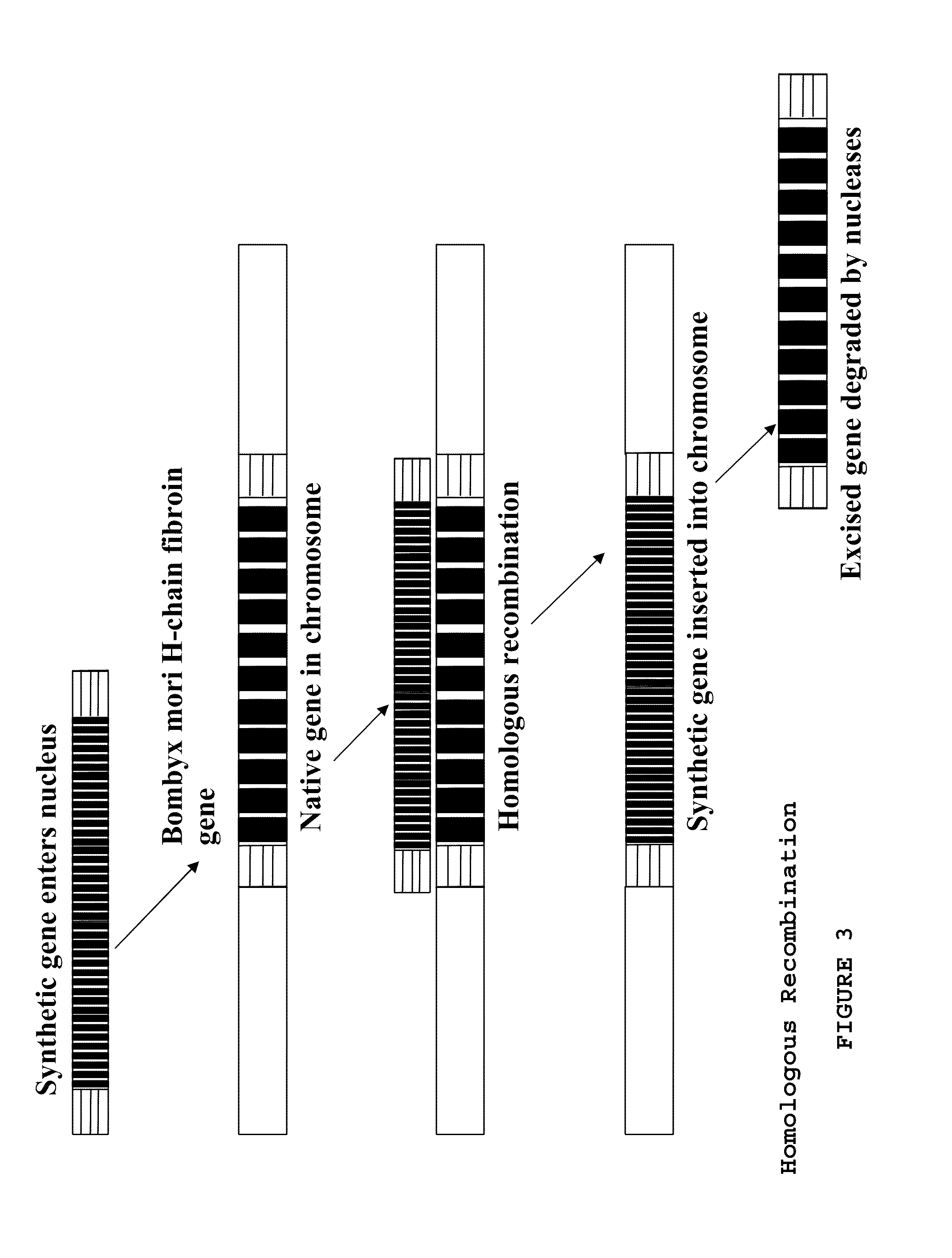Methods, compositions and systems for production of recombinant spider silk polypeptides
a technology of spider silk and polypeptides, which is applied in the directions of peptides, applications, peptide sources, etc., can solve the problems of human reproduction, unsatisfactory success in spinning silk from purified precursors, and not being particularly well suited for bioreactors
- Summary
- Abstract
- Description
- Claims
- Application Information
AI Technical Summary
Benefits of technology
Problems solved by technology
Method used
Image
Examples
example 1
Design of the 5′ and 3′ Homologous Ends
[0149]The NCBI Entrez database was used to determine the sequence of the Bombyx mori heavy chain fibroin gene. Wu and Cao (J Zheijian Univ Sci., (2004) 5(6):644-650) had success using homologous sections of about 1 kb, Rubnitz and Subramani (Mol Cell Biol. Nov. 4, 1984(11): 2253-2258) report a sharp drop in efficiency below 214 bp. The 5′ homologous section contains an intron of about 1 kb, and ˜30 bp was added to each end to avoid possible effects on post-translational processing. To facilitate possible further use of the gene construct with other promoters, organisms, etc., the decision was made to begin the 5′ sequence with the ATG start codon. This leaves the upstream promoters untouched and the intron in its normal place after homologous recombination. The 5′ sequence was modified to have a BspEI restriction site at the 3′ end to match with the internal repeat sequence 5′ restriction site (FIG. 5).
[0150]The 3′ sequence was chosen to start ...
example 2
Design of the Internal Repeat Segment
[0151]NCBI Entrez was consulted to obtain published sequences of Nephila dragline silk which were used to determine commonly repeated motifs. These were reduced to 13 commonly occurring sequences, 4 of which are heavily represented in the highly repetitive portion of the gene: LGGQGAGAAAAAAAGGAGQGG (SEQ ID NO: 40), GYGGLGSQAGRGG (SEQ ID NO: 37), LGGQGAGQ (SEQ ID NO: 38), and GSGRGG (SEQ ID NO: 39). The sequences (SEQ ID NOS: 37, 38, and 39) were arranged into higher order motifs to reflect an approximation of the natural gene. The 316 amino acid sequence with nine beta sheet forming regions (shown in FIG. 4A) was translated into a DNA sequence and edited to reduce repeated codons, remove selected restriction sites, and reflect Bombyx codon biases. A BspEI site was added at the 5′ end, and an XmaI site at the 3′ end.
[0152]Spider silk undergoes a phenomenon called supercontraction. When wetted, it greatly reduces its length, and becomes more plasti...
example 3
Assembling the Gene
[0153]The three gene segments had NcoI, BspEI, or XmaI restriction sites added so that they would remain in-frame when joined end to end, i.e., the 5′ end (SEQ ID NO: 5) joined to the spider silk internal repeat (I) (SEQ ID NO: 1) joined to the 3′ sequence (SEQ ID NO: 8). Plasmid p5′ containing the Bombyx 5′ homologous end (5′ end, or 5′) (SEQ ID NO: 5) and plasmid pI containing the internal repetitive section (I) (SEQ ID NO: 1) were digested with BspEI and NcoI. The digests were then run on agarose gel. The cut pI and 5′ end bands were extracted with a glassmilk procedure and 0.1 μg of each were ligated and transformed into NEB's 10-beta E. coli to produce plasmid p5′I. Plasmids p5′I and p3′ (containing the Bombyx 3′ homologous end) were digested with XmaI and NcoI. The 5′I section and the cut p3′ plasmid were gel purified and 0.1 μg of each were ligated and transformed into 10-beta E. coli, to generate plasmid p5′I3′. A preparation of p5′I3′ was split and half d...
PUM
| Property | Measurement | Unit |
|---|---|---|
| length | aaaaa | aaaaa |
| weight percent | aaaaa | aaaaa |
| weight percent | aaaaa | aaaaa |
Abstract
Description
Claims
Application Information
 Login to View More
Login to View More - R&D
- Intellectual Property
- Life Sciences
- Materials
- Tech Scout
- Unparalleled Data Quality
- Higher Quality Content
- 60% Fewer Hallucinations
Browse by: Latest US Patents, China's latest patents, Technical Efficacy Thesaurus, Application Domain, Technology Topic, Popular Technical Reports.
© 2025 PatSnap. All rights reserved.Legal|Privacy policy|Modern Slavery Act Transparency Statement|Sitemap|About US| Contact US: help@patsnap.com



